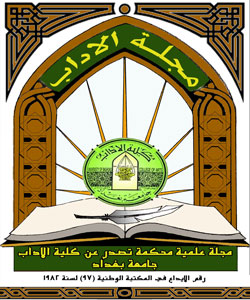Analysis of Adjacency Pairs of Cristiano’s Interview
DOI:
https://doi.org/10.31973/aj.v2i146.4326الكلمات المفتاحية:
Cristiano، Interview، Adjacency pairs، quantitative، qualitativeالملخص
Conversation is a vital tool in communication for communicating meaningful pieces of interactions. Adjacency pairs are often seen as fundamental units in conversational organization. The form and purpose of a specific pair component, as well as the context beside the stage of the conversation, all play essential roles in determining the meaning and function of an utterance. Each pair has special intended meaning, purpose and function which cannot be fully understood without relying on the context at which the adjacency pairs appear. The present study tends to focus on adjacency pairs within sports interviews with the aim of studying these pairs pragmatically since defining the underlying expectations on which the regularities are founded is difficult. The study also aims at examining the adjacency pairs included in the exchanges between the TV interviewers as well as the footballers, finding out the communicative purposes behind the adjacency pairs usage that the player wishes to transmit when being interviewed. The method used for analysis is a mixed one (quantitative and qualitative) to analyze the latest interview for the player. The qualitative analysis examines the content of the utterances descriptively and the quantitative analysis relies on a table, under the interview, that shows the rates of the types of adjacency pairs. So, the selected interview is analyzed in terms of number, types, frequency and distribution of adjacency pairs. The adopted model is an eclectic one which composes Cook's (1989) model of Adjacency Pairs, Van Dijk's (2006) model of Context and Grice's (1975) model of Cooperative Principles.
التنزيلات
المراجع
Asher, R. E. (1994) “Conversation: Quantity.” The Encyclopedia of Language and Linguistics Volume 2. UK: Pergamon Press Ltd.
Austin, J. L. (1962) How to Do Things With Words. Oxford University Press
Cook, G. 1989. Discourse. Oxford: Oxford University Press.
Cummins, C. & Katsos, N. (2019).The Oxford Handbook of Experimental Semantics and Pragmatics. Oxford: Oxford University Press.
Cutting, J. (2002). Pragmatics and Discourse: A Source Book for Students. London: Routledge.
Dornerus, E. (2005). Breaking maxims in conversation a comparative study of how scriptwriters break maxims. In Desperate housewives and that 70’s show. Retrieved on October 10th, 2012, fromhttp://www.kau. divaportal.orgsmash-getdiva.pdf.
Fisher, R. J. (2012). The Social Psychology of Intergroup and International Conflict Resolution. New York: Springer-Verlag Publishing.
Grice, H. P. (1975). Logic and Conversation. In P. Cole & J. Morgan (Eds.), Syntax & Semantics 3: Speech acts (pp. 4-5). New York: Academic Press.
Grice, H. P. (2004). Logic and conversation.Berkeley: University of California.
Levinson, S. 1983. Pragmatics. Cambridge: Cambridge University Press. Chapter 6, Conversation Structure.
Levinson, S. C. & Enfield, N. J. (2020). Roots of Human Sociality: Culture, Cognition and Interaction. London: Bloomsbury Publishing, Ltd.
Levinson, S. C. (1983). Pragmatics. Cambridge: Cambridge University Press
Macagno, F. & Capone, A. (2021). Inquiries in Philosophical Pragmatics: Theoretical Development. New York: Springer International Puplishing.
Mey, J. (1993). Pragmatics: An Introduction. Oxford : Blackwell Publisher
Paltridge, B. 2000 Making Sense of Discourse Analysis. Queensland: antidopedean Educational Enterprises.
Paltridge, B.2006. Discourse Analysis: An Introduction. London:Continuum.
Peccei, J. S. (1991). Pragmatics. London: Routledge
Rastier, F. (ed.) (2001). "A Little Glossary of Semantics". Texto! Textes & Cultures (Electronic journal) (in French). Translated by Larry Marks. Institut Saussure. ISSN 1773-0120. Retrieved 30 July 2022.
Rüegg, L.(2014). “Thanks Responses in Three Socio-Economic Settings: A Variational Pragmatics Approach.” Journal of Pragmatics, vol. 71, Elsevier B.V., Sept. 2014, pp. 1730, https://www.sciencedirect.com/search/advanced?docId=10.1016/j.pragma.2014.07.005.
Saeed, J. I. (2003). Semantics (Second ed.). Malden, MA: Blackwell Publishing Ltd
Skinner, B. F. (1948). Verbal behavior.New York: Appleton Century Crofts Inc.
Van Dijk, T. A. (2006). Discourse, Context and Cognition. Discourse Studies 2006; 8; 159 DOI: 10.1177/1461445606059565. The online version of this article can be found at: http://dis.sagepub.com/cgi/content/abstract/8/1/159. Copyright © 2006 SAGE Publications.(London, Thousand Oaks, CA and New Delhi) www.sagepublications.com Vol 8(1): 159–177.10.1177/1461445606059565.
Yule, G. (1996). Pragmatics. Oxford: Oxford University Press.
التنزيلات
منشور
إصدار
القسم
الرخصة

هذا العمل مرخص بموجب Creative Commons Attribution 4.0 International License.
:حقوق الطبع والنشر والترخيص
بالنسبة لجميع البحوث المنشورة في مجلة الآداب، يحتفظ الباحثون بحقوق النشر. يتم ترخيص البحوث بموجب ترخيص Creative Commons CC BY 4.0 المفتوح ، مما يعني أنه يجوز لأي شخص تنزيل البحث وقراءته مجانًا. بالإضافة إلى ذلك ، يجوز إعادة استخدام البحث واقتباسه شريطة أن يتم الاستشهاد المصدر المنشور الأصلي. تتيح هذه الشروط الاستخدام الأقصى لعمل الباحث وعرضه.
:إعادة إنتاج البحوث المنشورة من الناشرين الآخرين
من الضروري للغاية أن يحصل الباحثون على إذن لإعادة إنتاج أي بحث منشورة (أشكال أو مخططات أو جداول أو أي مقتطفات من نص) لا يدخل في نطاق الملكية العامة أو لا يملكون حقوق نشرها. يجب أن يطلب الباحثون إذنًا من مؤلف حقوق النشر (عادة ما يكون الناشر).
يطلب الإذن في الحالات التالية:
بحوثك الخاصة المنشورة من قِبل ناشرين آخرين ولم تحتفظ بحقوق النشر الخاصة بها.
مقتطفات كبيرة من بحوث أي شخص أو سلسلة من البحوث المنشورة.
استخدم الجداول والرسوم البيانية والمخططات والمخططات والأعمال الفنية إذا لم يتم التعديل عليها.
الصور الفوتوغرافية التي لا تملك حقوق لنشرها.
لا يطلب الإذن في الحالات التالية:
إعادة بناء الجدول الخاص بك مع البيانات المنشورة بالفعل في مكان آخر. يرجى ملاحظة أنه في هذه الحالة يجب عليك ذكر مصدر البيانات في شكل "بيانات من ..." أو "مقتبس من ...".
تعتبر عروض الأسعار القصيرة معقولة الاستخدام العادل ، وبالتالي لا تتطلب إذنًا.
الرسوم البيانية ، الرسوم البيانية ، المخططات ، الأعمال الفنية التي أعاد الباحث رسمها بالكامل والتي تم تغييرها بشكل ملحوظ إلى درجة لا تتطلب الاعتراف.
الحصول على إذن
لتجنب التأخير غير الضروري في عملية النشر ، يجب أن تبدأ في الحصول على أذونات في أقرب وقت ممكن. لا يمكن لمجلة الآداب نشر بحث مقتبس من منشورات أخرى دون إذن.
قد يمنحك مالك حقوق الطبع والنشر تعليمات بشأن شكل الإقرار الواجب اتباعه لتوثيق عمله ؛ بخلاف ذلك ، اتبع النمط: "مستنسخ بإذن من [المؤلف] ، [كتاب / المجلة] ؛ نشره [الناشر] ، [السنة]." في نهاية شرح الجدول ، الشكل أو المخطط.
.jpg)























